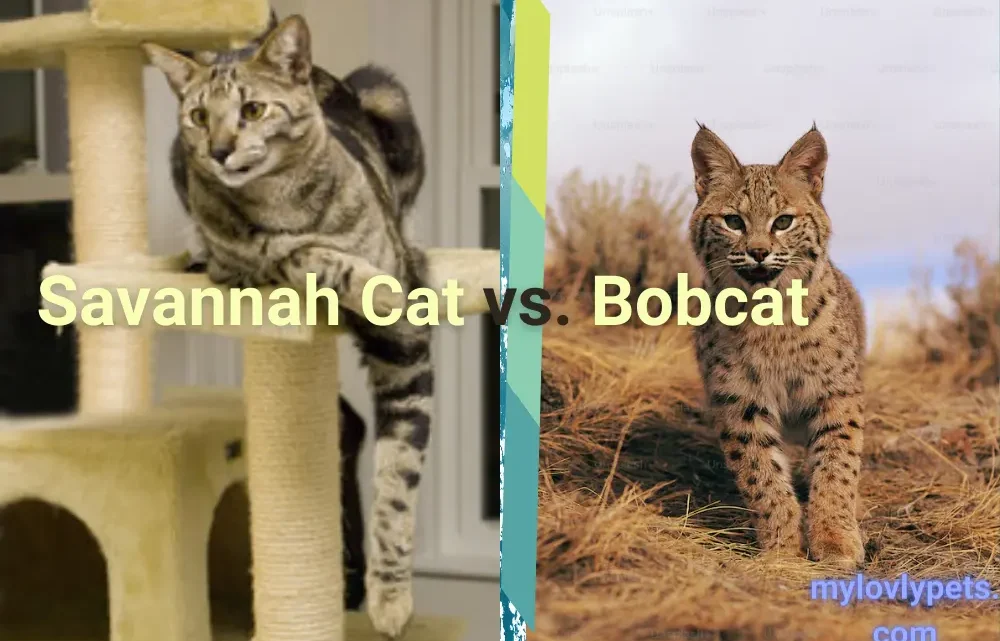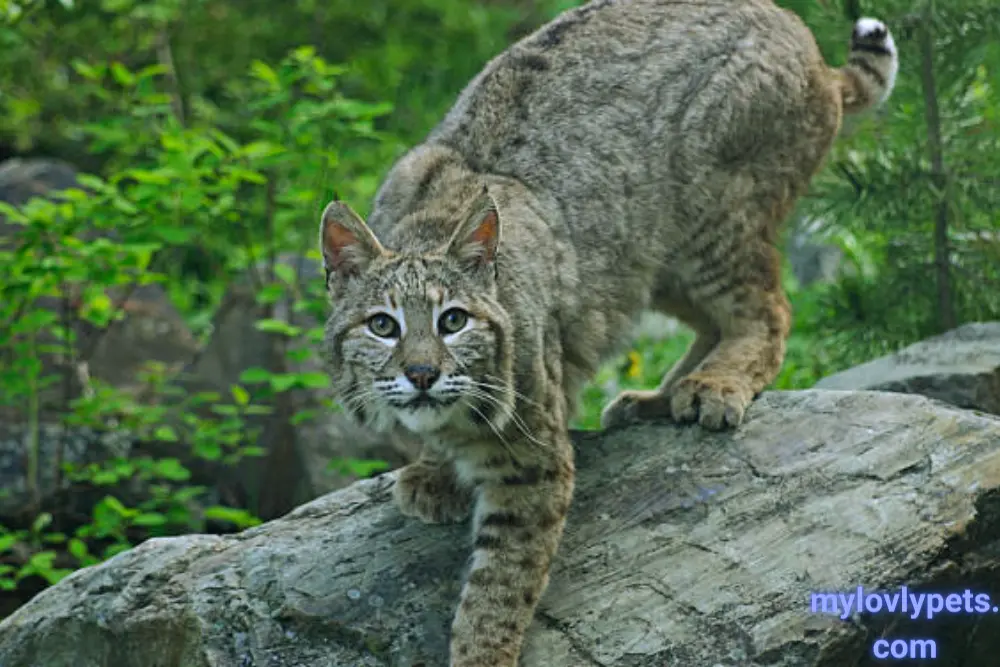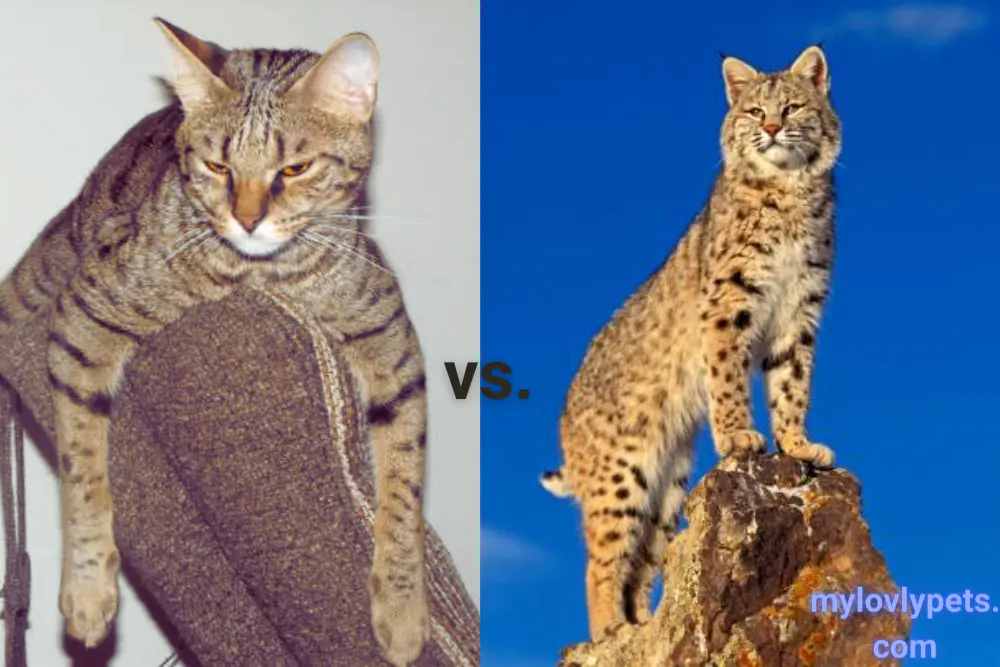
Savannah Cat vs. Bobcat: Key Differences and Similarities
This Savannah Cat vs. Bobcat comparison initially caught our attention because of their captivating charm and unique characteristics.
Discovering the similarities and differences between cats sparks our curiosity and illuminates the remarkable diversity among them. Savannah cats, a unique blend of house cats and servals, along with bobcats, native to North America, offer a captivating insight into the realms of the wild and domestic.
The Savannah cat is a unique and fascinating breed. Its origins can be traced back to a blend of African serval and domestic cat ancestry. This hybrid breed was first born in 1986 and named after the serval’s natural habitat, reflecting its wild charm.
Savannah Cats: The Domestic Hybrids

Breed Overview
In terms of physical characteristics, Savannah cats are strikingly beautiful. They’re tall and lean with long legs, giving them a graceful appearance. They have large ears and a distinct spotted coat, which can range from tawny to smoky black. Some even have a solid black coat without spots.
In terms of temperament, Savannah cats are known for their affectionate and social nature. They are highly intelligent and trainable, often following their owners around like “Velcro cats.” While they enjoy playtime and exercise, they are not the type to curl up on your lap all day.
These cats have gained popularity among those who appreciate their unique blend of wild and domestic traits. However, potential owners should be aware of their exercise needs and the challenges that come with owning such an active and playful breed. Additionally, it’s important to check local laws and regulations regarding Savannah cat ownership, as they can vary by location.
History and Recognition
Savannah cats have a relatively short but intriguing history. It all began in 1986 when the first Savannah cat was born. This kitten, appropriately named Savannah, was a unique mix of the African serval and a domestic cat.
Over time, breeders recognized the potential of these hybrids and embarked on a journey to establish the Savannah breed. Their efforts paid off when, in 2001, The International Cat Association officially recognized Savannah cats as a distinct breed. This recognition was a significant milestone, acknowledging the beauty and unique traits of Savannah cats.
Common Health Concerns
Savannah cats may face certain health concerns. One common issue is hypertrophic cardiomyopathy, a heart condition. Additionally, hybrid male sterility is expected in some cases. To keep them healthy, it’s essential to meet their specific dietary and grooming needs, which include brushing their short coat to prevent hairballs and ensuring they get the right nutrition to support their well-being. Regular vet check-ups are important to address any health issues that may arise.
Bobcats: The Wild Natives

Range and Background
There aren’t many wild cats in Connecticut, but there are a lot of them in North America. They didn’t get much love here in the past. From 1935 to 1971, their heads were even put on sale. Things are different now. More bobcats have been seen in Connecticut over the years. They can now be seen in all eight counties, mostly in the northwest.
Bobcats live in more than just Connecticut, though. They have a huge area of land that covers all of North America. These cats are tough and flexible, which helps them live in a variety of places. Even though they’ve had some problems in the past, they’ve held on and done well in many parts of Africa. So, if you’re in North America, keep an eye out for these elusive wildcats.
Characteristics and Habitat
Bobcats are native North American wildcats, often found in the United States. They’re about twice the size of a regular house cat, with a distinctive look, including a short, “bobbed” tail, prominent cheek ruffs, and tufts of black hair on their ears. Their fur usually has a mix of tawny and gray shades, which change with the seasons.
Bobcats are known for their solitary lifestyle, typically preferring to roam on their own, and they have a keen sense of territory. They live in a variety of habitats, including forests, deserts, and grasslands, as long as there’s enough cover for them to hunt and hide.
Behavior
Hunting is in their blood, and they’re agile predators. Their diet includes small mammals like rabbits, squirrels, and even the occasional deer. While they sometimes catch domestic animals, bobcats play an essential role in controlling wild animal populations and maintaining the balance of ecosystems.
Though they were once threatened, bobcats are now considered a species of least concern due to conservation efforts.
Savannah Cat vs. Bobcat: Key Differences
| Key Differences | Savannah Cats | Bobcats |
| Size and Appearance | Savannah cats are typically smaller, weighing between 12 to 25 pounds. | Bobcats are larger, with adult males weighing 18 to 35 pounds. |
| Savannah cats have a lean build, long legs, and spotted coats. | Bobcats are stout with distinctive features like short tails, prominent cheek ruffs, and tufted ears. | |
| Legal Ownership | The legality of owning Savannah cats varies by location, with permits required in some areas. | Bobcats are generally not legal as pets without special permits due to their wild nature. |
| Domestication | Savannah cats are a domesticated breed resulting from a cross between a serval and a domestic cat. | Bobcats are wild and remain in their natural habitats, showing minimal domestication. |
| Temperament | Savannah cats are affectionate, sociable with owners, and can adapt well to domestic life. | Bobcats are wild animals with solitary tendencies and are not known for domestication. |

Savannah Cat vs. Bobcat: Similarities
| Fascinating Similarities | Savannah Cats | Bobcats |
| Hunting Instincts | Both possess a strong hunting instinct. Savannah cats have a natural inclination for hunting, often seen pouncing on toys. | Bobcats are born hunters, actively pursuing prey like rabbits and birds in the wild. |
| Communication | Both exhibit vocalizations and use body language to communicate. Savannah cats are vocal, with meows, chirps, and expressive body language. | Bobcats use vocalizations (hisses, growls) and body language to convey emotions and intentions, like ear positions and tail movements. |
| Grooming Habits | Both are meticulous groomers. Savannah cats groom themselves regularly. | Bobcats are dedicated to grooming, maintaining their fur for hunting efficiency. |
| Playfulness | Both are playful and curious. Savannah cats are known for interactive play, chasing toys, and exploring. | Bobcats exhibit playfulness in their daily routines, engaging in activities like stalking and pouncing. |
Responsible Ownership of Savannah Cats
Owning a Savannah cat is a unique experience, but it comes with important responsibilities. These cats are affectionate, intelligent, and social, making them wonderful companions. However, they are also highly active and need plenty of exercise and playtime. It’s vital to ensure they have a safe and stimulating environment, like tall cat trees, as they love to climb and explore. Savannahs are not the type to sit still all day; they require interaction and mental stimulation.
Proper grooming, regular vet visits, and training are essential for their well-being. Savannah cats can be leash-trained and even play fetch, thanks to their dog-like qualities. As a responsible owner, you should invest time and effort into these aspects of care.

Conservation Awareness for Bobcats
Keeping wild bobcats as pets is not a responsible choice. Bobcats are native to North America and play a crucial role in the ecosystem. Their populations have been impacted by factors like habitat loss and hunting. It’s our duty to protect these species and their habitats.
Instead of keeping bobcats as pets, consider supporting conservation efforts and educational programs. You can help by learning more about these wild creatures and advocating for their protection. By appreciating bobcats in their natural habitat, we can contribute to the preservation of our unique wildlife.
Final Words
In conclusion, when comparing Savannah Cat vs. Bobcat, it’s essential to recognize their differences and shared characteristics. Savannah cats, despite their wild ancestry, are domesticated hybrids known for their affectionate and social nature, making them great companions for families. In contrast, bobcats are untamed, essential for the ecosystem, and rarely suitable as pets.
Responsible ownership, legal awareness, and respect for wildlife are crucial, whether you’re considering a Savannah cat or observing bobcats in the wild. Understanding local laws is essential for the conservation of these species and for ensuring their well-being as pets.


